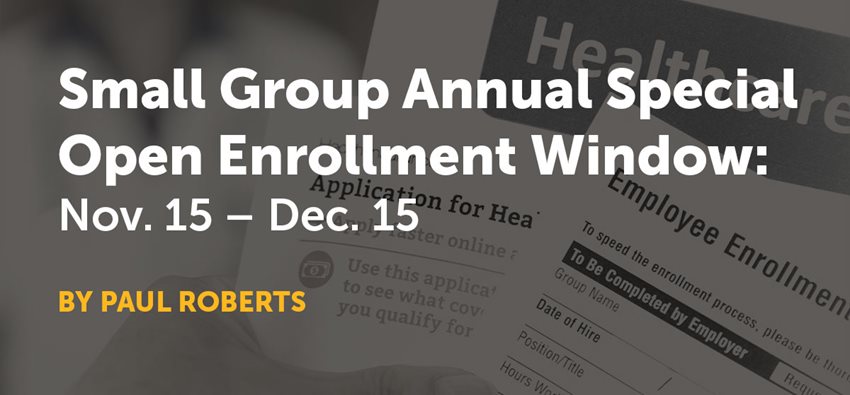Small Group Annual Special Open Enrollment Window: Nov. 15 – Dec. 15

The Affordable Care Act (ACA) requires medical health insurers to offer a one-month Special Open Enrollment Window (SOEW), when eligible Small Group employers can enroll in medical coverage without having to meet standard employer-contribution and/or employee-participation ratios.
The SOEW occurs November 15 through December 15 of each year, allowing eligible Small Group employers to enroll for coverage effective January 1 of the following year.
Background
The ACA has a section called the “guaranteed issuance of coverage in the individual and group market.” It stipulates that “each health insurer that offers health insurance coverage in the individual or group market in the state must accept every employer and individual in the state that applies for such coverage.”
The section also states that this guaranteed issuance of coverage can only be offered during (special) open enrollment periods, and that plans can only be offered to applicants who live in, work in, or reside in the plans’ service area(s).
Participation and Contribution Requirements
In many states (including California and Nevada), carriers can decline to issue group health coverage if fewer than 50-70% of employees elect to enroll. Some carriers may have even tighter participation requirements.
Furthermore, insurance carriers’ underwriting contribution rules require employers to contribute a certain percentage of premium costs for all employees in order to attain group health coverage. Some businesses struggle to meet these contribution requirements for a variety of financial reasons.
Problem Solved: Special Open Enrollment Window
Many employers want to offer coverage to their employees, but are denied because they struggle to meet participation and/or contribution requirements. Employers cannot force employees to enroll in coverage unless the employer pays for 100% of the employees’ premiums, which many employers cannot afford – especially for major medical policies. Even with moderate to generous employer contributions, many employers still find young and lower-income employees waiving coverage. This has been even more evident since 2019, with the ACA’s federal Individual Mandate non-compliance penalty reduced to $0.00. Although, at least in California, that changed a bit in 2020 when the state implemented its own Individual Mandate, with steep non-compliance penalties for adults and families in California. Nevada and many other states do not have a state individual mandate requirement.
The U.S. Department of Health & Human Services provides final guidance on this in regulation 147.104(b)(1): “In the case of (medical) health insurance coverage offered in the small group market, a health insurance issuer may limit the availability of coverage to an annual enrollment period that begins November 15 and extends through December 15 of each year in the case of a plan sponsor that is unable to comply with a material plan provision relating to employer contribution or group participation rules.”
If your employer groups (in the Small Group market) are struggling with meeting participation and/or contribution requirements, the Special Open Enrollment Window is the time to enroll them in coverage.
Important ACA Consideration for Applicable Large Employers (ALEs)
It’s important to note that Applicable Large Employers (ALEs) with 50+ FTEs are still subject to the ACA’s Employer Shared Responsibility mandate – even when/if the ALE enrolls in coverage during this Special Open Enrollment Window without having to meet standard participation and contribution requirements.
The Employer Shared Responsibility mandate requires ALEs to offer affordable health coverage to full-time (FT) employees and their dependents to age 26, or face potential non-compliance penalties. The affordability ratio for plan years beginning in January 2022 is 9.66%. This means a FT employee should not pay more than 9.66% of his or her rate of pay, end-of-year W-2 box 1 income, or of the Federal Poverty Level, on the lowest-cost, minimum-value plan offered by the employer (at the employee-only rate) in order to satisfy the ACA employer mandate for plan years beginning in 2022. The ACA affordability ratio for plan years beginning in 2021 is 9.83%.
Carrier References
Word & Brown has developed state-specific resources that explain medical carriers’ Underwriting rules, requirements, and extra procedural information for the 2020 Special Open Enrollment Window. Refer to the California SOEW reference piece, and/or the Nevada SOEW reference piece – or search “Special Open Enrollment” in the Form Library on the Word & Brown website.
For more help with the SOEW, consult your Word & Brown representative or the WBCompliance team (via email at ComplianceSupport@wordandbrown.com).
Most Recent Articles
Technology
Carrier Updates

